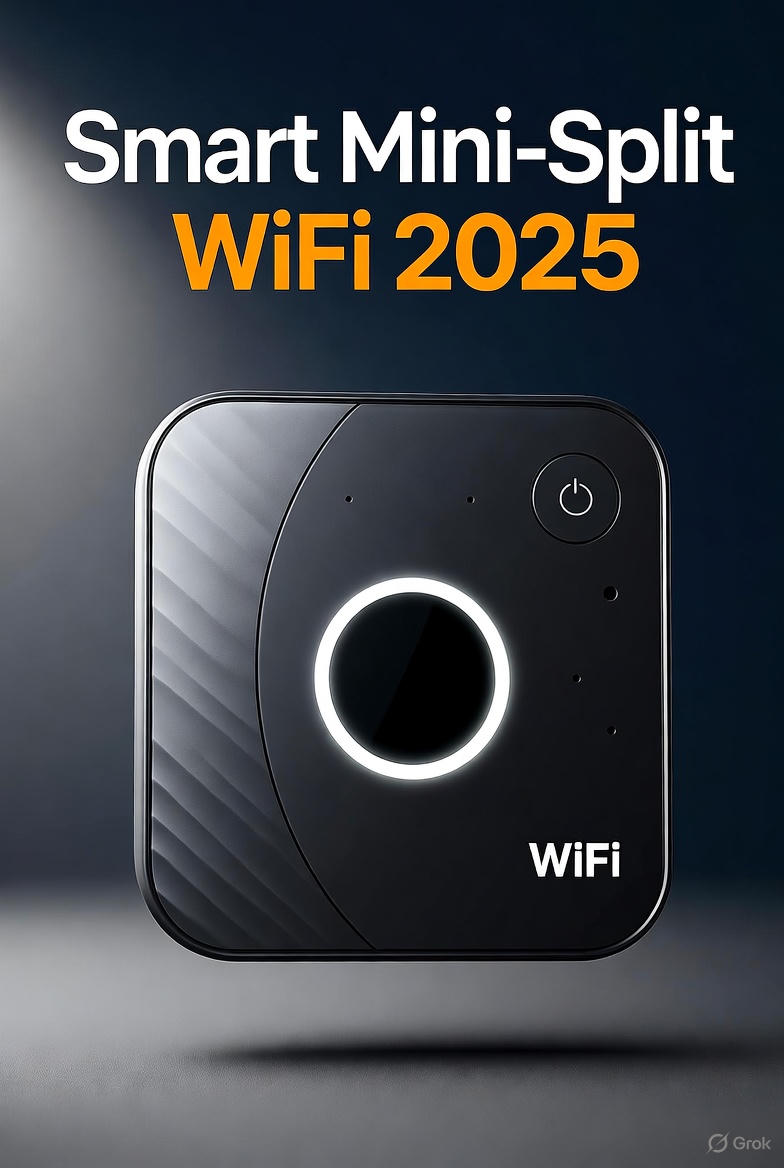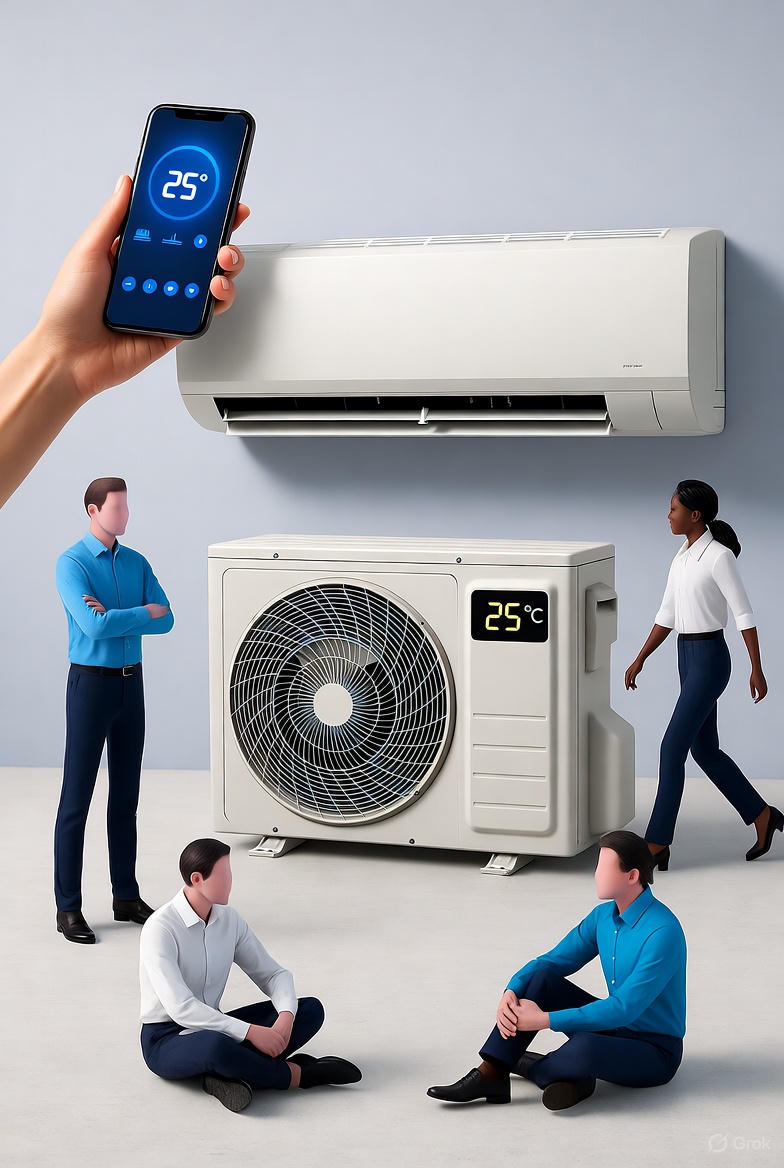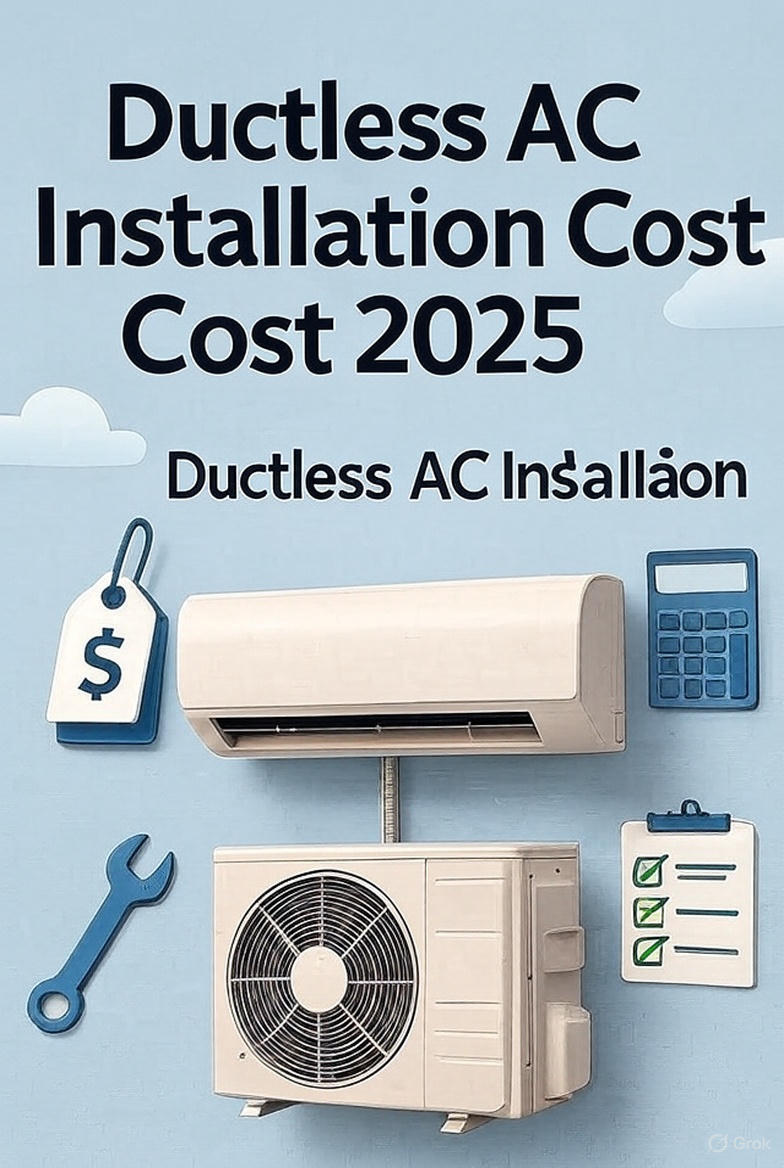When Jennifer Martinez installed her first mini-split in her Phoenix home office last summer, she quickly learned the frustration of forgetting to pre-cool the space before her afternoon Zoom calls. By 2 PM, the Arizona sun had turned her 150-square-foot workspace into an oven, and she'd waste the first 20 minutes of every meeting adjusting her temperature while the system struggled to catch up. Everything changed when she added a $129 Cielo Breez WiFi controller and configured a simple geofencing automation through Google Home.
Now her mini-split automatically kicks on when she's 15 minutes from home, greeting her with a comfortable 72°F workspace instead of a sweltering 88°F hotbox. Her monthly cooling costs for that room dropped from approximately $78 to $52—a 33% reduction—simply because she's no longer running the system all day "just in case." Over a typical seven-month Phoenix cooling season, that's $182 in savings from a device that paid for itself in under eight months.
Jennifer's experience illustrates what modern smart mini-split technology delivers: genuine convenience that translates into measurable energy savings. Whether you're upgrading an existing mini-split with a WiFi adapter or purchasing a system with built-in smart features, the combination of voice control, automated scheduling, and remote monitoring transforms how you interact with your home comfort system.

Types of Smart Mini-Split Connectivity
Built-In WiFi: The Gold Standard for Smart Control
Built-in WiFi represents the most reliable path to smart mini-split control. These systems integrate the WiFi module directly into the indoor unit during manufacturing, connecting seamlessly to your home network through the manufacturer's dedicated app with cloud-based remote access from anywhere. The approach eliminates compatibility concerns and provides manufacturer-backed support for the entire smart ecosystem.
The major advantage comes from this seamless integration—you're not adding third-party hardware that might conflict with your system or void warranties. When Michael Chen in Seattle purchased his Mitsubishi M-Series with kumo cloud connectivity last year, setup took approximately 12 minutes from unboxing to full smartphone control. Compare that to the troubleshooting marathon some homeowners face with incompatible third-party adapters, and the value proposition becomes clear.
Several major manufacturers now offer native WiFi connectivity. Mitsubishi's kumo cloud platform provides exceptional reliability and features. Daikin's Daikin One system delivers professional-grade control with energy monitoring. LG integrates their ThinQ platform across their entire mini-split lineup, while Samsung leverages their SmartThings ecosystem for unified home control. Zone Air's WiFi-capable models bring smart features to the value segment, offering Alexa and Google Home integration without the premium pricing of luxury brands. Fujitsu rounds out the field with their FGLair app, known for its clean interface and responsive control.
The cost premium for built-in WiFi typically ranges from nothing (included in many mid-range and premium models) to approximately $100-200 for systems where it's offered as an optional upgrade. Given that third-party controllers cost $99-189 anyway, built-in WiFi often represents better value with superior integration.
WiFi Adapters: Bringing Smart Features to Existing Systems
WiFi adapters offer a retrofit path for mini-splits that don't include native smart capabilities. These plug-in modules connect to your existing system via the control wire port, translating commands from a smartphone app or web interface into signals your mini-split understands. Think of them as a smart translator sitting between your phone and your air conditioner.
The appeal is straightforward—you can add smart features to a non-WiFi system for $50-150 without replacing functional equipment. Sarah Thompson in Austin faced this exact scenario when she inherited a 2019 Senville mini-split with her home purchase. The system worked perfectly, but she wanted the remote control and scheduling capabilities her previous apartment's smart thermostat offered. A $129 Cielo Breez adapter transformed her "dumb" mini-split into a fully app-controlled system in under 30 minutes, giving her geofencing, voice control through Alexa, and weekly scheduling—all without spending $2,000+ on a new unit.
The tradeoff comes in the form of compatibility limitations and slightly less polished integration compared to native WiFi systems. Some adapters work via infrared (mimicking your remote control), while others connect directly to the unit's control board. Manufacturer-specific adapters typically offer the best integration but cost more and work only with their brand. Check your warranty documentation before installing any third-party adapter, as some manufacturers consider them warranty-voiding modifications.
Popular universal options include the Cielo Breez series ($99-149), which works with over 20,000 mini-split models and offers ENERGY STAR certification for proven efficiency. The Sensibo Sky ($119-159) adds air quality monitoring to its control features, while the Flair Puck brings wireless IR control to over 200 brands. The Ambi Climate ($189) uses AI to learn your preferences and automatically adjust settings. For brand-specific systems, manufacturer adapters from Mitsubishi, Daikin, and LG typically run $99-179 and provide the tightest integration with their respective ecosystems.
Smart Home Hub Integration: Unified Control
Smart home hubs elevate mini-split control from standalone app management to unified whole-home automation. Your mini-split connects to a central hub—whether that's Amazon Alexa, Google Home, Apple HomeKit, Samsung SmartThings, or advanced platforms like Home Assistant or Hubitat—creating a single control interface for every smart device in your home. This integration enables sophisticated automation scenarios that span multiple device types.
The practical difference becomes apparent in real-world use. David Park in Denver runs a Home Assistant setup that coordinates his two mini-split zones with smart window shades, occupancy sensors, and weather data. On sunny winter afternoons when outdoor temps hit 45°F but his south-facing living room climbs to 76°F from solar gain, his occupancy sensors detect he's home, automatically raise the shades to block direct sun, and shift his mini-split from heating to cooling mode—all without touching a single control. These cross-device automations represent smart home technology at its most useful, moving beyond simple remote control to genuine intelligence.
Most mini-split manufacturers support integration with major platforms. Amazon Alexa and Google Home offer the easiest entry points with broad compatibility. Apple HomeKit provides superior privacy and security but supports fewer mini-split brands directly (though Homebridge can bridge the gap). Samsung SmartThings offers middle-ground flexibility, while Home Assistant and Hubitat cater to enthusiasts willing to invest time for maximum control and local operation without cloud dependencies.
Voice Control: Convenience That Actually Works
Amazon Alexa Integration
Setting up Alexa control for your mini-split takes roughly five minutes once your system connects to WiFi. Install your mini-split manufacturer's app first and ensure the system connects to your network successfully. Open the Alexa app, navigate to Skills & Games, and search for your manufacturer's skill (e.g., "kumo cloud" for Mitsubishi or "SmartHVAC" for MrCool). Enable the skill, link your account credentials, and let Alexa discover your devices. Finally, assign each unit to a room or group for easier voice control.
The voice commands work exactly as you'd expect. "Alexa, turn on the bedroom AC" powers up your system. "Alexa, set bedroom temperature to 72" adjusts your setpoint. "Alexa, make it cooler" or "make it warmer" nudges the temperature by a few degrees. "Alexa, set AC to cooling mode" switches operating modes, while "Alexa, what's the bedroom temperature?" provides current readings.
Where Alexa really shines is in routine creation and automation. Lisa Nguyen in Miami created a "Movie Night" routine that dims her living room lights, lowers her smart shades, and drops her mini-split temperature to 68°F—all triggered by the phrase "Alexa, movie time." Her "Good Morning" routine gradually warms her bedroom from the energy-saving overnight setpoint of 64°F to a comfortable 70°F starting 30 minutes before her alarm, so she wakes to comfort instead of a blast of hot air. These routines transform discrete voice commands into complete scene control, and you can trigger them by time, temperature thresholds, or device states.
Google Home Integration
Google Home setup follows a similarly straightforward path. After configuring your mini-split in the manufacturer's app, open Google Home and tap the plus icon to add a device. Select "Works with Google," search for your manufacturer's integration (like "LG ThinQ" or "Daikin Online"), and link your account. Google Home automatically discovers your mini-split and prompts you to assign it to a room for easier voice control and automation.
Voice commands mirror Alexa's functionality with Google's phrasing. "Hey Google, turn on the living room AC" powers your system. "Hey Google, set AC to 70 degrees" adjusts temperature, while "Hey Google, make it cooler" or "turn off heating" handle mode and comfort adjustments. Google Home excels at natural language processing—you can say "make the bedroom comfortable" and Google interprets that based on your historical preferences and current conditions.
The Home/Away routines prove particularly valuable. James Rodriguez in San Diego configured his Google Home to detect when both he and his partner leave their geofence radius, automatically setting their two mini-split zones to eco mode (78°F in summer, 62°F in winter). When either phone re-enters the 10-minute arrival radius, both zones return to comfort settings. This automation slashed their combined cooling costs from approximately $185 monthly to $128—a $57 monthly savings or $684 annually—without sacrificing comfort when they're actually home.
Apple HomeKit: Premium Privacy
Apple HomeKit support remains more limited in the mini-split world, with fewer manufacturers offering native integration compared to Alexa and Google platforms. Daikin offers HomeKit compatibility on select premium models, while certain LG systems support it through their ThinQ platform. Many enthusiasts bridge the gap using Homebridge, a software solution that translates non-HomeKit devices into HomeKit-compatible endpoints, though this requires running Homebridge on a dedicated computer or Raspberry Pi.
Voice control through Siri works seamlessly when available. "Hey Siri, set bedroom to 72 degrees," "turn on the AC," or "make it cooler" all function as expected. The real advantage of HomeKit isn't voice control—it's privacy and local operation. HomeKit automations can run entirely locally without cloud dependencies, meaning your mini-split responds to triggers even during internet outages. For privacy-conscious users, Apple's strict HomeKit certification requirements and local-first architecture provide peace of mind that their climate control data isn't feeding advertising profiles or third-party analytics platforms.
Mobile App Features: Your Climate Command Center

Modern mini-split apps transform your smartphone into a comprehensive climate control center. Temperature adjustment works exactly as you'd expect—set your target temperature, adjust in 1°F increments, and view current room readings in real-time. Mode selection lets you switch between Cool, Heat, Dry, Fan, and Auto modes remotely, while scheduling allows you to program mode changes for different times of day. Fan speed control offers Low, Medium, High, and Auto settings, letting you balance comfort against noise levels. On/off control provides remote power management, scheduled operation, and emergency shutoff capability from anywhere.
These basics merely scratch the surface of what quality apps deliver. The real value emerges in advanced features that transform simple remote control into intelligent climate management.
Seven-day scheduling forms the foundation of smart mini-split efficiency. Program multiple daily schedules for weekday versus weekend patterns, enable vacation mode when traveling, and let adaptive scheduling learn your patterns over time. Rachel Kim in Portland programmed her bedroom mini-split to drop to 62°F at 11 PM when she typically goes to sleep, warm to 68°F at 6:30 AM before her alarm, then switch to economy mode at 8 AM after she leaves for work. This simple schedule cut her bedroom energy consumption by 42% compared to leaving the system at a constant 68°F—dropping her monthly bedroom cooling and heating costs from approximately $48 to $28.
Energy monitoring transforms invisible consumption into actionable data. Real-time power consumption shows exactly how many watts your system draws under different conditions. Daily, weekly, and monthly reports reveal patterns and trends. Cost tracking estimates your spending based on local utility rates, while efficiency recommendations suggest optimization opportunities. When Tom Anderson in Chicago noticed his energy reports showing 30% higher consumption during a cold snap compared to similar temperatures earlier in the season, he checked his filters and found them completely clogged—a problem that might have gone unnoticed for months without energy monitoring, potentially costing hundreds in wasted electricity and reduced equipment lifespan.
Geofencing automation represents the killer feature for busy households. Your app monitors your phone's location, automatically adjusting temperature when you leave or arrive based on a configurable radius. Support for multiple users ensures the system doesn't switch to economy mode while your partner remains home. The energy savings prove substantial—typically 20-35% compared to maintaining comfort temperatures while the home sits empty all day. Maintenance alerts remind you when filters need cleaning, notify you of upcoming service requirements, explain error codes in plain language, and provide diagnostic information. Temperature history displays historical data charts, revealing usage patterns, efficiency trends, and comparative analysis across different time periods. Multi-unit control lets you manage multiple zones from a single interface, synchronize operation across systems, create group controls for whole-home comfort, or make individual adjustments to specific zones.
Smart Home Automation Examples
Morning Routine
Trigger: 6:30 AM weekdays
Actions:
- Set bedroom AC to 72°F
- Switch to fan mode (circulate air)
- Turn on gradually (avoid sudden noise)
Implementation:
- Alexa: Custom routine
- Google: Home routine
- HomeKit: Automation
Leaving Home
Trigger: Geofence exit OR "Alexa, I'm leaving"
Actions:
- Set all zones to 78°F (summer) or 65°F (winter)
- Switch to eco mode
- Reduce fan speed to minimum
- Send confirmation notification
Energy Savings: 20-30% compared to running at comfort temperature
Arriving Home
Trigger: Geofence entry (15-minute radius)
Actions:
- Set temperature to 72°F
- Switch to cooling/heating mode
- Resume normal fan speed
- Pre-condition before arrival
Result: Comfortable home upon arrival without running all day
Bedtime Routine
Trigger: "Alexa, good night" OR 10:30 PM
Actions:
- Set bedroom AC to 68°F (ideal sleeping temp)
- Reduce fan to low (quiet)
- Turn off other zones
- Enable sleep mode
Temperature-Based Automation
Trigger: Outdoor temp > 85°F
Actions:
- Lower indoor setpoint by 2°F
- Increase fan speed
- Close smart blinds (if integrated)
Trigger: Indoor temp > setpoint + 3°F
Actions:
- Switch to turbo mode
- Alert user of issue
- Check filter status
Vacation Mode
Trigger: Manual activation
Actions:
- Set all zones to 85°F (summer) or 55°F (winter)
- Minimal operation (prevent extremes only)
- Send weekly status updates
- Alert on abnormal conditions
Energy Savings: 80-90% compared to normal operation
Energy Monitoring & Optimization
Real-Time Monitoring
What You Can Track:
- Current power consumption (watts)
- Instantaneous efficiency
- Operating mode
- Runtime hours
- Compressor cycles
Benefits:
- Identify inefficient operation
- Spot issues early
- Optimize settings
- Reduce waste
Historical Analysis
Data Available:
- Daily energy usage
- Weekly/monthly trends
- Cost estimates
- Comparison to previous periods
- Weather correlation
Actionable Insights:
- Peak usage times
- Inefficient patterns
- Optimization opportunities
- Budget forecasting
Automated Optimization
Smart Scheduling:
- AI learns occupancy patterns
- Adjusts automatically
- Minimizes waste
- Maximizes comfort
Demand Response:
- Reduce load during peak hours
- Utility integration (where available)
- Earn credits/rebates
- Grid-friendly operation
Efficiency Alerts:
- Notify of unusual consumption
- Suggest filter cleaning
- Recommend maintenance
- Identify performance degradation
Security & Privacy Considerations
Data Security
What Manufacturers Collect:
- Usage patterns
- Temperature settings
- System performance
- Error logs
- (Usually NOT video/audio)
Security Features to Look For:
- Encrypted connections (SSL/TLS)
- Two-factor authentication
- Local network option
- Privacy policy transparency
Best Practices:
- Use strong WiFi password
- Keep firmware updated
- Review app permissions
- Use separate IoT network (advanced)
Privacy Concerns
Potential Issues:
- Usage patterns reveal occupancy
- Data sharing with third parties
- Potential for hacking (rare)
- Terms of service changes
Mitigation:
- Read privacy policy
- Opt out of data sharing where possible
- Use local control options
- Consider offline-capable systems
Troubleshooting Common Issues
Can't Connect to WiFi
Checklist:
- WiFi enabled on unit?
- Correct network credentials?
- 2.4GHz network (not 5GHz)?
- Router within range?
- Firewall blocking?
- Too many devices on network?
Solutions:
- Reset WiFi module
- Move router closer
- Use WiFi extender
- Update router firmware
- Check manufacturer support
App Won't Control Unit
Checklist:
- Internet connection active?
- Unit powered on?
- App updated?
- Account logged in?
- Cloud service operational?
Solutions:
- Restart app
- Re-pair device
- Check service status
- Contact support
Voice Commands Not Working
Checklist:
- Skill/integration enabled?
- Device discovered?
- Correct wake word?
- Clear command syntax?
- Unit responding to app?
Solutions:
- Re-discover devices
- Re-link account
- Check command phrasing
- Verify app control works first
Best Smart Mini-Split Systems 2025
Premium Smart Features
Daikin Aurora ($2,800-4,200)
- Advanced app control
- Excellent automation
- Superior air quality monitoring
- Energy tracking
- Smart home integration
Mitsubishi M-Series ($2,500-4,000)
- Kumo Cloud app
- Alexa/Google integration
- Geofencing
- Energy reporting
- Reliable connectivity
Best Value Smart Systems
Zone Air WiFi Models ($1,899-2,499)
- Built-in WiFi (select models)
- Alexa/Google compatible
- Energy monitoring
- Scheduling
- U.S.-based support
- Excellent price-to-feature ratio
LG Art Cool ($2,200-3,400)
- ThinQ integration
- Voice control
- Smart scheduling
- Beautiful design
- Good app functionality
Budget Smart Options
Senville WiFi Models ($1,100-1,600)
- Basic WiFi connectivity
- Mobile app control
- Scheduling
- Limited smart home integration
- Acceptable for price
Smart Home Integration Strategies
Start Simple
Phase 1: Basic Control
- Set up manufacturer app
- Test remote control
- Create basic schedule
- Familiarize with features
Phase 2: Voice Control
- Link to Alexa or Google
- Test voice commands
- Create simple routines
- Refine commands
Phase 3: Automation
- Add geofencing
- Create advanced routines
- Integrate with other devices
- Optimize for efficiency
Advanced Integration
Home Assistant Setup:
- Local control (no cloud)
- Advanced automation
- Custom dashboards
- Integration with everything
- Requires technical knowledge
Multi-System Coordination:
- Sync multiple zones
- Integrate with thermostats
- Coordinate with smart vents
- Whole-home comfort management
Future of Smart HVAC
Emerging Technologies
AI-Powered Optimization:
- Learns preferences automatically
- Predicts occupancy
- Optimizes for comfort + efficiency
- Weather-aware operation
Energy Storage Integration:
- Coordinate with home batteries
- Pre-cool during cheap power hours
- Reduce peak demand
- Maximize solar utilization
Health Monitoring:
- Air quality sensors
- Allergen detection
- Humidity optimization
- Sleep quality monitoring
Predictive Maintenance:
- AI detects issues early
- Schedules service automatically
- Orders parts proactively
- Minimizes downtime
Frequently Asked Questions
Can I add WiFi to my existing mini-split that doesn't have it built-in?
Yes, absolutely. Universal WiFi adapters like the Cielo Breez ($99-149), Sensibo Sky ($119-159), or Flair Puck work with most mini-split brands through infrared control or direct wiring connections. These retrofit solutions transform non-smart systems into app-controlled, voice-enabled, automation-ready climate systems without replacing your existing equipment. Installation typically takes 15-30 minutes and requires no special tools beyond a smartphone and WiFi network. The main limitation involves compatibility—verify your specific mini-split model appears on the adapter's compatibility list before purchasing. Some manufacturers also offer brand-specific WiFi modules that provide tighter integration than universal options, though these cost slightly more and work only with that manufacturer's systems.
Do I need a WiFi adapter if my mini-split already has a remote control?
Standard infrared remotes provide basic control, but they can't deliver the automation, remote access, and energy monitoring capabilities that WiFi connectivity offers. Your remote works only within line-of-sight range of the indoor unit, requires manual operation for every adjustment, and provides no scheduling, geofencing, or usage tracking. WiFi adapters that work via infrared essentially function as smart remotes—they mimic remote control signals but add app control, voice commands, automated scheduling, and remote operation from anywhere with internet access. If you frequently forget to adjust your mini-split before leaving home, want to monitor energy consumption, or wish to integrate climate control into smart home routines, a WiFi adapter delivers functionality your remote simply cannot provide, regardless of how advanced that remote might be.
Will adding WiFi control void my mini-split warranty?
The answer depends on how the WiFi module connects and what your warranty terms specify. Built-in WiFi systems from the manufacturer never void warranties—they're part of the original equipment. Manufacturer-approved WiFi adapters (like Mitsubishi's kumo cloud adapter for older units) typically maintain warranty coverage since they're officially supported accessories. Universal third-party adapters present more complexity. Infrared adapters that simply mimic your remote control don't physically modify your system and generally don't affect warranties. Adapters that wire directly into control boards may void warranties with some manufacturers, particularly if installation causes damage or if the manufacturer's terms explicitly prohibit third-party modifications. Before installing any third-party WiFi adapter, review your warranty documentation carefully and consider contacting your manufacturer's customer service for clarification. Some manufacturers welcome third-party smart controls, while others take a more restrictive approach.
How much can I actually save on energy costs with smart mini-split features?
The savings depend heavily on your usage patterns, but the numbers prove substantial for most households. Geofencing automation typically delivers 20-30% energy savings by running the system in economy mode while you're away instead of maintaining comfort temperatures in an empty home. A household spending $150 monthly on mini-split operation could save $30-45 monthly through geofencing alone—$360-540 annually. Intelligent scheduling adds another 10-20% savings by automatically adjusting temperatures during sleep hours and adjusting setpoints based on actual occupancy rather than running constant temperatures 24/7. Combined, smart features commonly reduce energy consumption by 30-40% compared to leaving a system at a fixed comfortable temperature around the clock. The payback period for a $129 WiFi adapter often runs under one cooling or heating season for active users. Energy monitoring provides additional savings by identifying inefficient operation, prompting filter maintenance, and revealing usage patterns you can optimize. Real-world examples consistently show $200-700 annual savings for typical households, with larger homes and more extreme climates seeing even greater benefits.
Can smart mini-splits work during internet outages?
This depends on the specific feature and system architecture. Basic functionality—on/off control, temperature adjustment, mode selection—typically works normally through your standard remote control even during internet outages, since mini-splits operate independently of internet connectivity. Smart features divide into two categories: cloud-dependent and local network. Cloud-dependent features like remote control from outside your home, voice commands through Alexa or Google Home, and smartphone app access from away obviously require internet connectivity. Local network features vary by system. Some WiFi modules support local network control, allowing smartphone app operation when your phone connects to the same WiFi network as your mini-split, even without internet access. Apple HomeKit excels here, with automations that run entirely locally without cloud dependencies—your mini-split responds to HomeKit triggers even during prolonged outages. Systems using Home Assistant or Hubitat with local integrations similarly maintain automation functionality. If internet reliability concerns you, prioritize systems that support local network control or consider Home Assistant for cloud-free automation capabilities. Always maintain your physical remote control as a backup for essential functions.
Do smart mini-splits pose security or privacy risks?
Smart mini-splits collect and transmit data, which does create potential privacy considerations, though the risks differ significantly from devices like smart cameras or voice assistants. Most mini-split systems collect usage data (operating hours, temperature settings, mode selections), performance metrics (power consumption, efficiency ratings), and error logs. They typically don't collect audio, video, or personally identifiable information beyond what's required for account creation. The main privacy concern involves usage patterns revealing occupancy—when you're home, sleeping, or away—which could theoretically be valuable to marketers or concerning if accessed by bad actors. Security risks primarily involve unauthorized access to your climate controls through compromised WiFi networks or weak account passwords. Mitigate these risks by using strong, unique passwords for your mini-split app account, enabling two-factor authentication where available, keeping your WiFi network secured with WPA3 encryption, installing firmware updates when released, and reviewing manufacturer privacy policies to understand data collection and sharing practices. Consider placing IoT devices on a separate network segment isolated from computers and phones for additional security. Reputable manufacturers like Mitsubishi, Daikin, and LG invest heavily in security and encrypt communications, making security breaches rare in practice.
Which voice assistant works best with mini-splits: Alexa, Google Home, or Siri?
Amazon Alexa and Google Home offer the broadest mini-split compatibility, with most major manufacturers supporting one or both platforms. Alexa provides slightly wider device support and more mature smart home routines, making it the safe choice for maximum compatibility. Google Home excels at natural language processing—you can use less rigid command phrasing—and integrates beautifully if you're already invested in the Google ecosystem. Both platforms support geofencing, scheduling, voice control, and integration with thousands of other smart devices for comprehensive automation. Apple HomeKit lags in mini-split support, with fewer manufacturers offering native compatibility. However, HomeKit delivers superior privacy protections, local automation that works without internet connectivity, and rock-solid security through Apple's certification requirements. If privacy ranks as your top priority and your mini-split supports HomeKit (or you're willing to run Homebridge), Siri provides compelling advantages despite the smaller device ecosystem. For most users, choosing between Alexa and Google Home comes down to which ecosystem you already use—both work excellently with mini-splits, and switching between them delivers minimal practical differences in daily mini-split control.
Conclusion
Smart mini-split systems offer convenience, efficiency, and comfort benefits that justify the modest price premium. Whether you choose built-in WiFi or retrofit with an adapter, smart features enhance the ownership experience while reducing energy costs.
Key Takeaways:
- Built-in WiFi is most reliable
- Voice control adds genuine convenience
- Automation delivers real energy savings (20-30%)
- Energy monitoring identifies waste
- Security concerns are manageable
Getting Started:
- Choose system with built-in WiFi or compatible adapter
- Set up manufacturer app
- Link to voice assistant
- Create basic automations
- Monitor and optimize
Questions About Smart Features? Call Zone Air: (801) 882-2324
Ready to Go Smart? View Zone's WiFi-Capable Systems
Related Resources:
About the Author: Ben Zuro is a Product Engineer at Zone Air specializing in mini-split system design, performance testing, and quality assurance. With hands-on experience in HVAC engineering and product development, Ben rigorously tests every system under real-world conditions to ensure Zone Air delivers exceptional performance and reliability. His technical expertise in thermal engineering and practical testing methodology helps bring innovative, high-quality mini-split systems to market. When not in the lab, Ben analyzes customer feedback to drive continuous product improvements and optimize system design.


